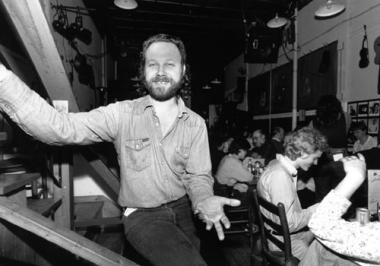These days, he’s busy saving historic houses. But before he was engaged with preservation, Jordi Herold was all things music. He opened the Iron Horse in 1979, and remained its booking agent until 2004—even after he sold the establishment in 1994. For the Advocate’s 35th anniversary, Herold discussed the Iron Horse’s relationship with the paper over the years, his present vocation and how the Valley has changed since since the ‘70s.
Advocate: What do you remember about the Advocate when you first started doing business in the Pioneer Valley? What was your impression of the paper then?
Jordi Herold: When I first started in business, the Advocate was already well established and had tons of “alternative” street cred for regional, investigative journalism. I remember the layout made me feel as if we had our own Village Voice. The arts /entertainment, advertising and editorial were well established (as were the then much more local and fascinating personal ads). I think everyone read the paper back to front. I remember offices that may still have been across from the Jones Library in Amherst. I remember that something being written up in the Advocate imparted a touch of hip.
What was your relationship with the Advocate during your first years at the Iron Horse?
Well, the Advocate was very interested in our opening. They had seen one of our first posters, “Opening Soon,” and ran a feature human interest piece. The writer asked us a bunch of questions: what we plan to do, what are our “influences,” etc. A few days before print she called my then-partner John Riley (now of Gabriel Books) and said, “I just want to clear up one quote. You said you were influenced by topless bars?” “No,” we said, “tapas bars!” Tapas wasn’t quite a household term then.
I made a big point of developing a relationship with David Sokol, who was music editor 1979-1994-ish, and his support was instrumental in establishing the club. That professional relationship became a friendship 25 years later. One time David was lamenting that he had to write about other people no matter how much interesting stuff was going on at the Horse—that he would have to not give us the coveted “Coming this Week” feature. I, being 24 or 25, simply purchased a similar-sized ad block and laid it out in identical format to his editorial. Got my wrist slapped by management for that one!
How do you feel about the role the Iron Horse plays in the Valley now as opposed to years past?
I think, in the language of today’s politics, the Horse was unwittingly transformative when it opened. People rallied around it. It was the nexus of music and personal community. Guerrilla theatres would tear through at lunch time, artists were on the walls. We were next door to Womonfyre Books [a lesbian bookstore] and would clean their windows when they were slimed at night so they would not have to come in to that in the morning.
We were by day Haymarket and Green Bean rolled into one, by night a music venue where you could expect the unexpected—whether that was that people more famous than you believed could be there, or people who just simply took your breath away.
Over time the club morphed. I sold it in 1994, though I continued programming through its 25th anniversary in 2004. But today’s Horse, especially since 1995, is unabashedly a concert venue. Every staff has its warmth and there are great people there today, both booking and taking care of folks. But the intimacy and neighborly feel seem at a remove.
What is the biggest change you see in the Valley now compared to 35 years ago?
Well, 31 years ago when I got my first apartment, it was $150; I now have to rent apartments in the same block for $1,650 just to pay my mortgage. When I first rented the Horse it was $375. I dare say that is not so anymore! I think the Valley was more conducive to energetic startups then, and I don’t just think it’s the rents. I really want to see energy from 20- and 30-something businesspeople on the main streets and not just working from home designing websites.
How did you get involved with moving/preserving historical houses?
Before there was the Horse there was Jordi, the long-haired hippy kid with a headband who looked the part of a guitar player in a band (hey, I was for a hot 10 minutes), but did his Hampshire College Division III as a research fellow at Historic Deerfield. Before that there was teenage Jordi who worked for one of New England’s antique barn experts and documented every inch of his family’s 1785 farmhouse. So that goes way back.
But more immediately, as I was taking a walk on Main Street one day in November, 2003, just weeks before retiring from music, I saw a sign in the door of architect Tris Metcalfe’s office: “Save this House.” I recognized the house; I’d always loved it, and the wheels started moving. When a hundred people told me it couldn’t be done, that clinched the deal. I moved that house 3.2 miles through downtown.
See? It does pay to put up posters.



